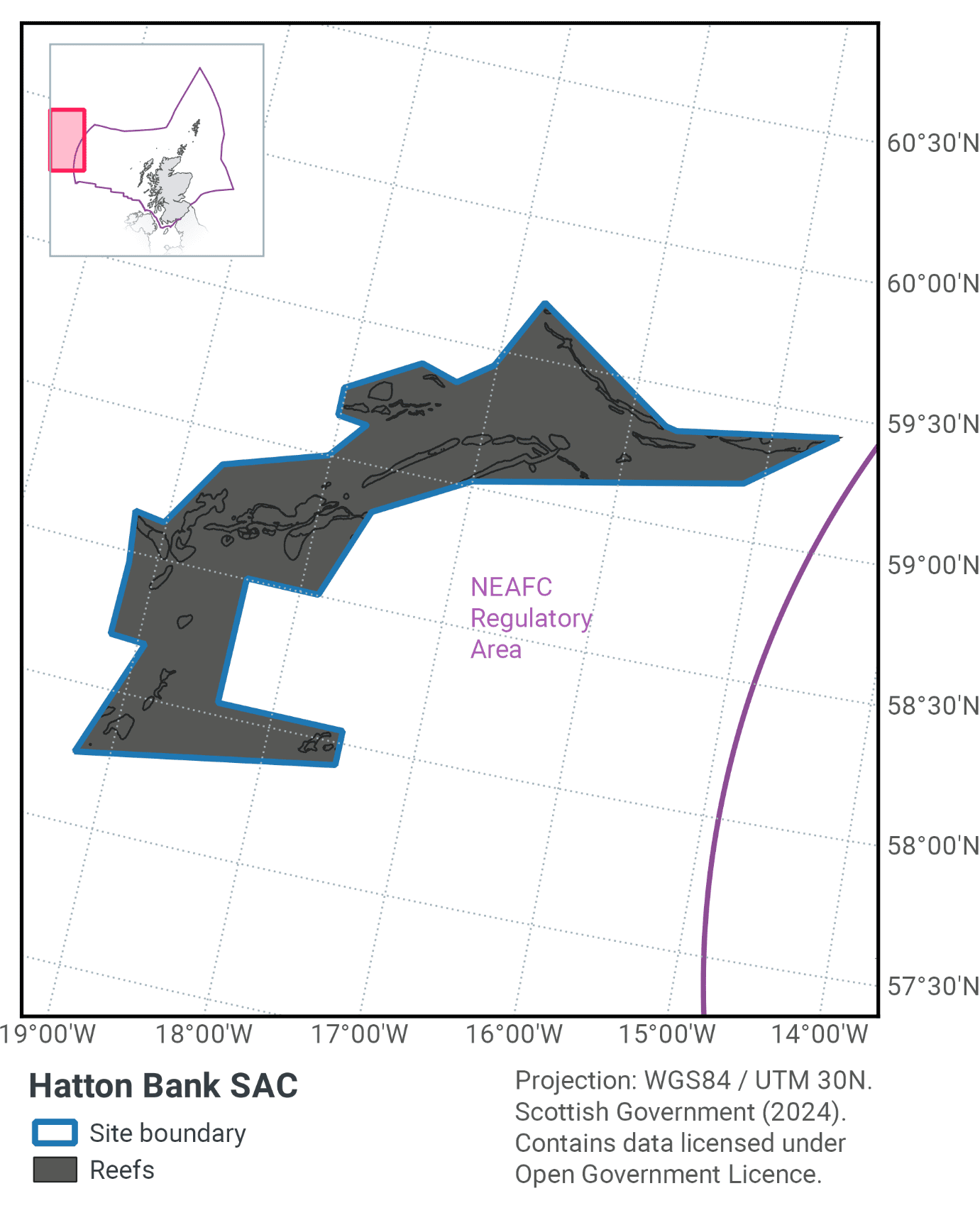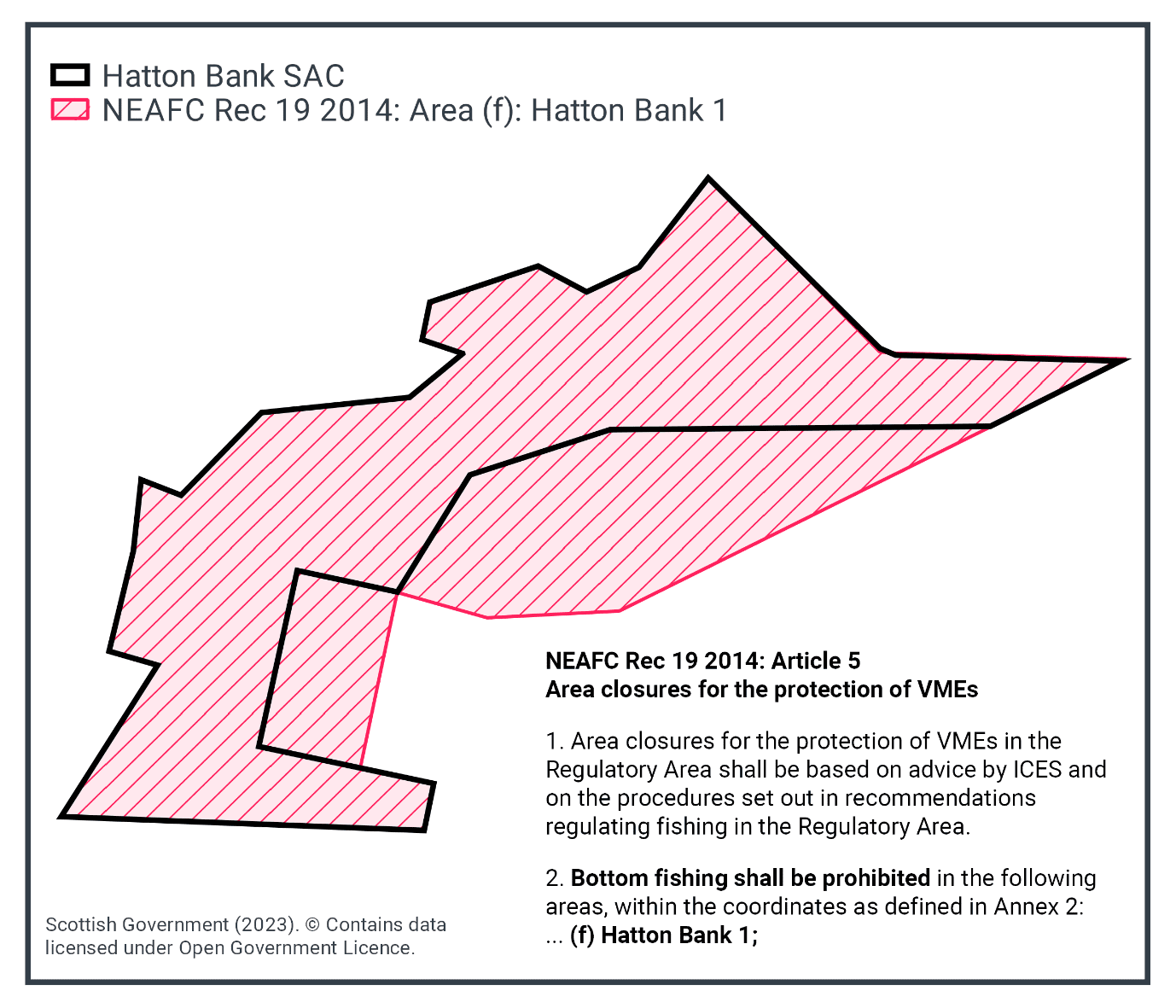Fisheries Management Measures within Scottish Offshore Marine Protected Areas (MPAs) - Site Proposal Document
This document describes the process, justification and evidence used to develop site specific management measures. It outlines key information for each site including their features, and risks of potential pressures.
21. Hatton Bank SAC
21.1 Description and background
The Hatton Bank SAC site is a large volcanic bank located in the Atlantic North-West Approaches Regional Sea, and represents hard bedrock reef, stony and biogenic Lophelia pertusa and Madrepora oculata reef in deep circalittoral waters (Figure 56). The bedrock reef is of low to high topographic complexity.
The vast size and topographic complexity of the Hatton Bank supports a wide diversity of biological communities, each associated with different geomorphological structures and substratum types (Howell et al, 2007). Much of the seabed on Hatton Bank comprises coarse sandy sediment; however the bank also supports extensive areas of bedrock reef (particularly on the ridges along the top of the bank), as well as many areas of stony reef. Iceberg ploughmarks, a variant of stony reef, shaped by the movement of icebergs during the last ice age, have been recorded at this site.
Further information can be found in the site information centre.

21.2 Site features
The Hatton Bank SAC is designated for the following protected features:
- Stony, bedrock and biogenic reef (Annex I Reefs).
The bedrock and stony reefs (including iceberg ploughmarks) at the site support biological communities representative of these two reef sub-types in the deep circalittoral. Individual colonies of scleractinian corals, soft corals, ‘lace’ corals (stylasterids), ‘black’ corals (antipatharians), cup corals and gorgonian sea fans were all recorded, interspersed with a variety of sponge species, including vase-shaped white sponges and glass sponges (Narayanaswamy et al, 2006; Howell et al, 2007). Xenophyophores (large single-celled protozoans), sessile sea cucumbers, anemones and brachiopods (bivalve molluscs) are also present.
The Lophelia pertusa and Madrepora oculata biogenic reef framework (comprising live and dead coral) sustain a variety of organisms representative of this biogenic habitat, including gorgonian, scleractinian and antipatharian coral types. Encrusting sponges; ascidians (sea squirts); serpulid worms, bryozoans; and a range of feather stars; basket stars and sea stars are also present (Narayanaswamy et al, 2006; Howell et al, 2007). Mobile epifauna include urchins, hermit crabs and brittle stars.
21.3 Site Boundary
The SAC boundary incorporates all known intact cold water coral reefs on Hatton Bank, as well as extensive areas of stony reef and bedrock reef. However, as the site covers such a large area JNCC do not have full coverage data across the entire site to clearly define all discrete areas of Annex I reef. In the absence of full coverage data JNCC has taken the boundary of the North East Atlantic Fisheries Commission (NEAFC) closure as a proxy for the location of Annex I reef and consequently the site map indicates that Annex I reef is occurring at depths down to 1740m but this is an artefact resulting from the way the closure area has been derived.
21.4 Conservation Objectives
JNCC’s view on the overall condition of the site’s qualifying feature is that it is in unfavourable condition and therefore needs to be restored to favourable condition.
The Conservation Objectives for the Hatton Bank SAC are for the feature to be in favourable condition thus ensuring site integrity in the long term and contribution to Favourable Conservation Status of Annex I Reefs.
This contribution would be achieved by maintaining or restoring, subject to natural change:
- The extent and distribution of the qualifying habitat in the site;
- The structure and function of the qualifying habitat in the site; and
- The supporting processes on which the qualifying habitat relies
The full conservation advice documents can be found on the JNCC website. This includes the formal conservation advice for the site, background information and the full conservation objectives.
21.5 Pressure from demersal mobile fishing gear
Whilst it is unlikely that demersal mobile gears can affect the long-term natural distribution of bedrock and stony reef features, there is evidence to indicate that their use can impact the structure and function of the habitat and the long term survival of its associated species.
The use of demersal mobile fishing gears is likely to cause damage or death of fragile, erect species, such as sponges and corals (Freese et al., 1999; Løkkeborg, 2005). Other species such as hydroids, anemones, bryozoans, tunicates and echinoderms may also be vulnerable (McConnaughey et al., 2000; Sewell & Hiscock, 2005). Where fragile, slow growing species occur, even low levels of fishing have the potential to change the structure and function of the habitats and may result in the loss of some characteristic species.
Demersal mobile gears reduce the long-term natural distribution of cold-water coral (biogenic reef) features, as well as impacting the structure and function of the habitat and the long term survival of its associated species. The passage of mobile fishing gear may increase mortality of the coral by crushing, burying or wounding corals, increasing susceptibility to infection and epifaunal recruitment that may eventually smother corals (Fosså et al., 2002).
The passing of a heavy trawl reduces the three-dimensional structure of the coral to rubble, decreasing the complexity of the habitat with impacts on the associated community composition (Koslow et al., 2001; Fosså et al., 2002). Indirect impacts on cold water coral reefs from trawling are from increased levels of suspended particles in the water column causing smothering and polyp mortality (Larsson & Purser, 2011). Given the slow growth rate of the reefs, they may take centuries to recover from damage, if at all (ICES, 2010).
21.6 Pressure from demersal static fishing gear
Mechanical impacts of demersal static gear (e.g. weights and anchors hitting the seabed, hauling gear over seabed, rubbing/entangling effects of ropes) can damage some species (Eno et al.,1996). Other species appear to be resilient to individual fishing operations, but the effects of high fishing intensity are unknown (Eno et al., 2001). Recovery will be slow (Foden et al., 2010) resulting in significant reduction or even loss of characteristic species. The individual impact of a single fishing operation may be slight but cumulative damage may be significant (Eno et al., 2001; Foden et al., 2010).
Demersal static gears are likely to reduce the long-term natural distribution of cold-water coral (biogenic reef) features, as well as impacting the structure and function of the habitat and the long term survival of its associated species. The impacts are considered to be lower than for demersal mobile gear types (Pham et al., 2014), however impacts to habitats and biota may occur during certain conditions. For example, hooks, lines, nets and ropes entangle corals and may pluck them during hauling (Grehan et al., 2004; ICES, 2010, Sampaio et al., 2012). Physical damage to the seabed has been observed which may be caused by dragged anchors (Grehan et al., 2004; ICES, 2010). The individual impact of a single fishing operation may be slight but cumulative damage can be significant. Given the slow growth rate of the reefs, they may take centuries to recover from damage, if at all (ICES, 2010).
21.7 Other fisheries measures which apply to the site
The full extent of Hatton Bank SAC has been closed to bottom fisheries since 2014 under NEAFC Rec 19 2014: Protection of VMEs in NEAFC Regulatory Areas, as Amended by Recommendation 09:2015 and Recommendation 10:2018. Further restrictions under The Common Fisheries Policy and Animals (Amendment etc.) (EU Exit) Regulations 2019 Statutory Instrument (S.I.) 2019, No. 1312 (amending S.I. 2019, No. 753) prohibit the use of bottom-set gillnets, entangling nets, and trammel nets at depths greater than 200 meters.
A map of the current measures in place can be viewed online at NMPI Marine Scotland - National Marine Plan Interactive.
21.8 Proposed fisheries management and rationale
Considering the management already in place, the site is considered to be sufficiently managed for the site conservation objectives and no further management is proposed, as displayed in Figure 57.

Contact
Email: marine_biodiversity@gov.scot
There is a problem
Thanks for your feedback